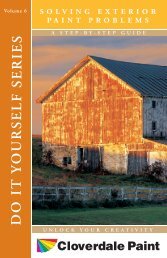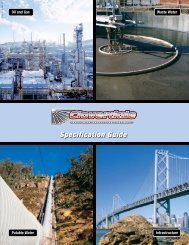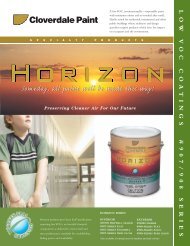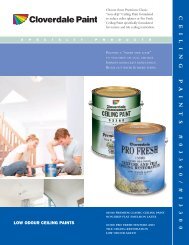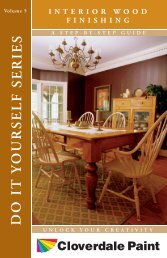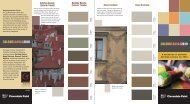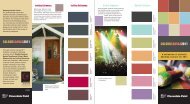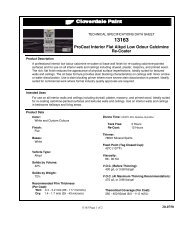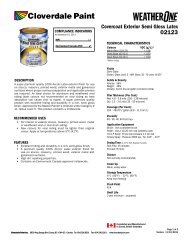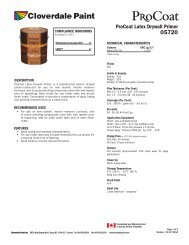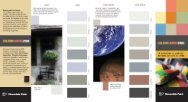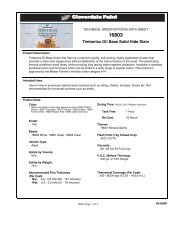83365 ClovaGrip Anti-Slip Epoxy - Cloverdale Paint
83365 ClovaGrip Anti-Slip Epoxy - Cloverdale Paint
83365 ClovaGrip Anti-Slip Epoxy - Cloverdale Paint
Create successful ePaper yourself
Turn your PDF publications into a flip-book with our unique Google optimized e-Paper software.
Surface Preparation:<br />
<strong>83365</strong><br />
Surface must be clean, dry, and free of contamination such as oils, grease, wax, loose rust or mill scale.<br />
An SSPC SP-6 Commercial Sandblast is recommended as a preparation for bare steel whether applying<br />
directly or using 83021 ClovaPrime 21 as a primer. Porous surfaces such as concrete and wood should be<br />
primed using 83021 ClovaPrime 21. New concrete should be wet cured for at least three days and allowed<br />
to dry with good ventilation for an additional 30 days.<br />
Methods of Application:<br />
<strong>ClovaGrip</strong> performs best when applied over a primer. Pre-mix base component with a mechanical mixer<br />
such as a pneumatic drill motor with a jiffy mixing blade. Make sure that all aggregate is lifted off bottom of<br />
the container and is uniformly dispersed. Pour the entire contents of the 83360(B) Activator into base<br />
material. Mix hardener for approximately 3 to 5 minutes until material assumes a uniform color and<br />
appearance. Working pot life is 2.5 hours at 70 o C. Pot life is extended at lower temperatures and<br />
decreases at higher temperatures. A-65 accelerator can be used in this product to speed up curing,<br />
however the pot life will be shorter.<br />
Spray:<br />
Spray application will result in a uniform appearance with good non-slip characteristics. A specialized<br />
mastic type spray equipment is required. A 5-gallon bottom outlet pressure tank equipped with a double<br />
regulator and air driven agitator, and 1" I.D. outlet pipe. A 25 feet of 3/8" female connectors at each end. A<br />
25 feet of 3/4" material hose with 3/4" female connectors at each end. A Binks Model 7E2 spray gun<br />
equipped with 1/4" (#45) fluid nozzle and a 1/4" internal air cap or a Binks Model 52-2012 (4 foot) pole gun<br />
equipped with the same fluid nozzle and air nozzle.<br />
Minimum air supply required is 20 CFM at 90 lbs. pressure. Recommended pressure is 15-20 psi on<br />
material and 20-25 psi on atomization. Always keep atomization air pressure higher than pot pressure.<br />
Keep agitator running slowly. Good coverage and film thickness will be obtained working at 18" or 24"<br />
distance from surface. Overlap strokes about 50%. Make sure of wet application. Very little abrasive<br />
rebound will be noticed at 15 psi; however, it will be more noticeable at higher pressures. When<br />
temperature is above 80oF, it is advisable to flush the spray equipment's with C-25 every hour or so in<br />
order to prevent the possibility of any material setting up and plugging the equipment.<br />
Trowel:<br />
Roller:<br />
Trowelled applications provide excellent non-slip characteristics with a rough, textured surface. Use a<br />
flexible blade plasterer's finishing trowel approximately 4 inches by 12 inches. Use smooth edges, not<br />
notched. Pour a "ribbon" on the surface approximately 2' long and 6" wide. Hold trowel at 45 degree angle<br />
to surface to spread with sweeping motion. Reverse angle of trowel for opposite stroke. pull material<br />
toward you. To cover corners, etc., pull straight strokes using material on the trowel. Trowel across welds<br />
to avoid an excessively thick application.<br />
Rolled applications provide the most aggressive non-slip characteristics with an irregular, ridged profile.<br />
Use a phenolic roller. It is important that the rolled profile expose the maximum amount of non-slip<br />
aggregate. If aggregate is not properly exposed, the coating may become slippery when wet. Pour a<br />
"ribbon" on the surface approximately 2' long and 6" wide. Roll material in one direction only, in slow<br />
straight strokes pulling material toward you with a moderate amount of pressure. Do not over-roll too many<br />
times or press down too heavily. Be careful that material does not build up too thickly along welds (roll<br />
across welds, not along them). Material applied too thickly may not properly cure. Higher temperatures<br />
will shorten drying time and conversely, lower temperature and high relative humidity will lengthen drying<br />
time. Exterior applications must be protected from rain for at least 12 to 24 hours after application<br />
according to the humidity. Protect from heavy or extended exposure to water, oil, and chemicals for 5 to 7<br />
days during final cure.<br />
<strong>83365</strong> Page 2 of 3 h30-0060



